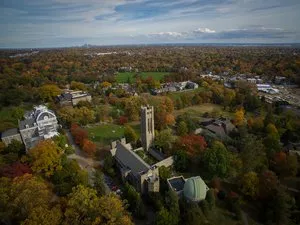Play On Philly Side-by-Side Performance with the Swarthmore College Orchestra

Play On Philly conductor Andrés Gonzàlez working with the Swarthmore Orchestra and Play on Philly string section at a joint rehearsal
On Saturday March 2, Swarthmore warmly welcomed students from Play on Philly (POP) to campus for tours, lunch, and a performance in Upper Tarble. Ranging from elementary school to high school, these students played side by side with Swarthmore College Orchestra members, myself included. Rainy weather made travel difficult, but the bright smiles from conductors Andrew Hauze ‘04 (Swarthmore) and Andrés Gonzàlez (POP) ensured the day was filled with laughter and good music from everyone in the ensemble.
POP is a non-profit organization that provides instruments and music education to underserved children in Philadelphia. Professor Hauze remarked, “An orchestra is an amazing ensemble that I love and that the students in our orchestra love, and I think it's so important to pass along that love so that it can touch young people early in their lives.” He went on to describe how POP’s focus on providing children who may not have access to early musical training with the proper equipment, space, and educators shows a clear commitment to their community and student musicians. They are dedicated to providing students with the means to succeed in life; the art of music making is a wondrous byproduct of the process.
Preparing a performance for an ensemble of around 120 musicians is no easy feat. The first issue to resolve was repertoire, as Professor Hauze explains: “We were looking for pieces that were at a good level for all of us, but that will also be fun and worthwhile with a very, very big [orchestra].” A special piece entitled Train-ella was co-commissioned by POP and several other youth orchestras. Composed by Nina Shekhar, the piece was written in the style of the classic word game Mad Libs, and it allowed young musicians to engage with the music in a new way. In place of traditional Mad Libs, where adjectives or verbs are slotted into a story to create a comedic mishmash of plots and narrative elements, students instead insert sounds. For example, one prompt was “A small animal.” POP students created a sound (a quick, scurrying glissando starting on a D) that would be played whenever that prompt came up in the narrative of the song. Other repertoire selections for the concert included Alberto Ginastera’s Dances from Estancia: Los Trabajadores Agrícolas, and Tchaikovsky’s Finale from Symphony No. 2 in C Minor, arranged by Sandra Dackow.
This collaboration was more than just a performance. It provided POP students with the opportunity to visit a renowned liberal arts college and actively engage with its community. It also allowed for Swarthmore students to “escape the bubble of Swarthmore,” as Professor Hauze put it, and to visit one of POP’s locations in Philadelphia for a rehearsal in February. Musicians from a large range of ages and skill levels worked together and learned in unison. In the viola section where I sit, several students asked us about our college experience and for advice on their audition pieces for all-state and other orchestras. My stand partner (a POP student) and I laughed frequently about the absurdity of Train-ella and played through the songs together with an occasional interjection of a musical joke (such as Megalovania or The Mii Theme). Both orchestras experienced a different kind of connection between musician and music.
“Students in our orchestra come from a very wide variety of backgrounds, experience levels in music, parts of the world,” Professor Hauze explains, “but the majority of them have had access to private lessons or maybe high schools with strong music programs, and these are things that are not always available [to everyone].” It’s through a shared love and appreciation for music that each and every student that participated in this event grew and developed a deeper understanding of themselves, their peers, and how music is handed from one set of musicians to the next.
This collaboration was an opportunity for two amazing music programs to interact and make lasting memories. Being able to engage with the music community in such a way can be difficult as a Swarthmore student unless you are extremely involved with music here. Through this event, Swarthmore and POP have shared the joy of not just music, but the beauty of making music with musicians both novice and experienced in a totally new, large-scale setting for the community. When first asked why he decided to work with Play on Philly, Professor Hauze said, “I so passionately believe in the importance of orchestras and orchestra music both to our culture, but also to bringing people together to make music in a totally unique way.” This event allowed me to reconnect with the roots of my musical career all while proving what Professor Hauze said: that orchestra music really does bring people together



